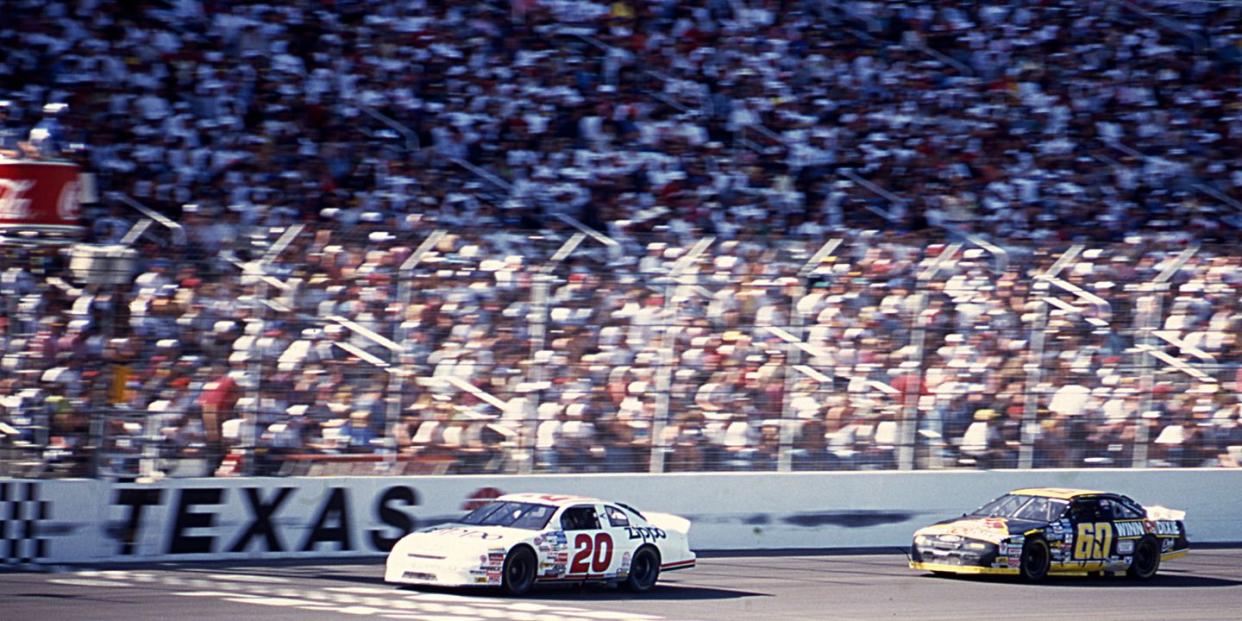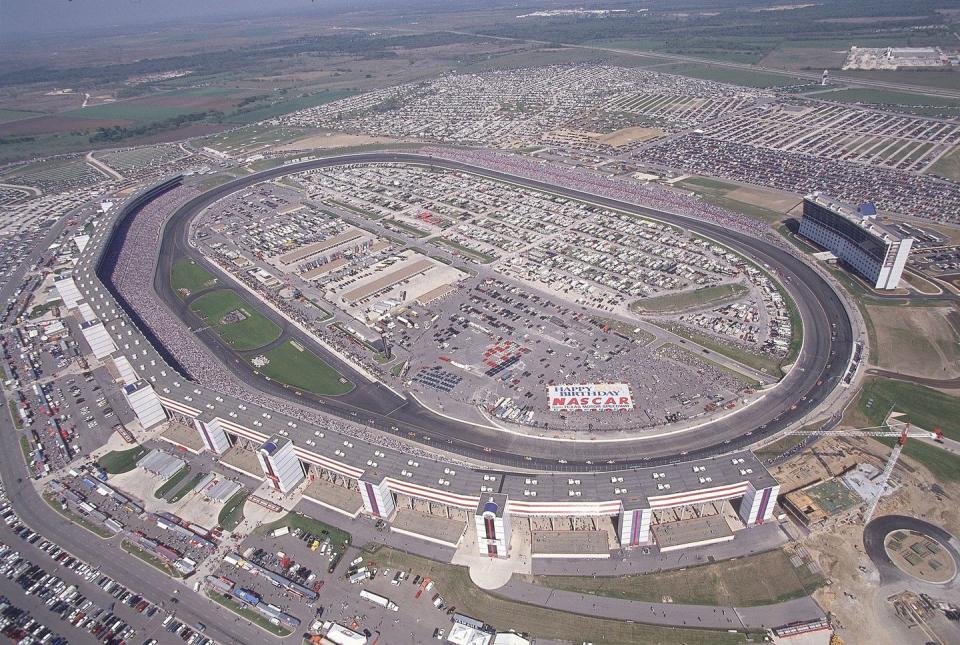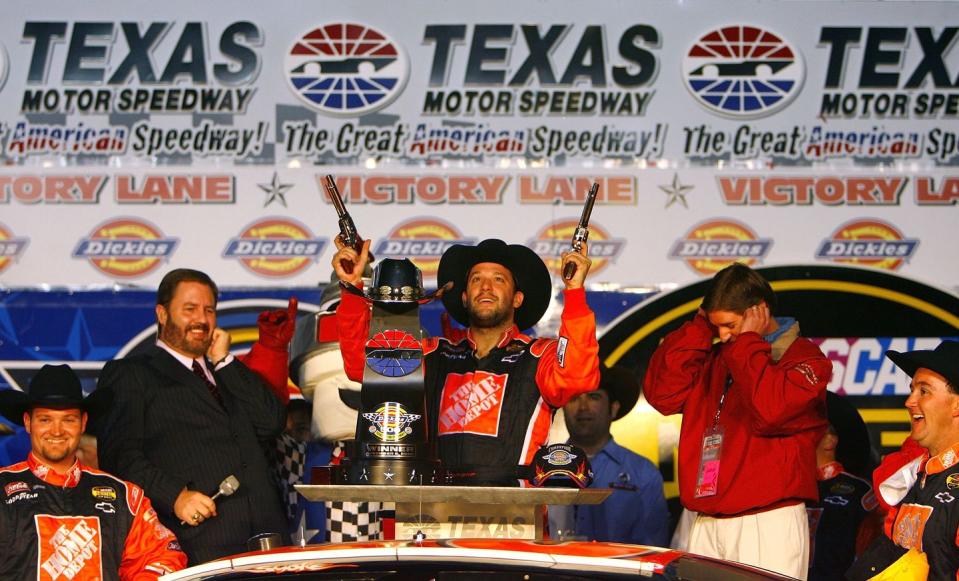NASCAR Playoff Race Adds Chapter to Texas Motor Speedway's Highlights and Lowlights

A quarter-century after its inaugural Cup Series race, the Track That Bruton Built is a very different place from the speedway that saw its first green flag fly for a NASCAR Cup race in 1997.
Jeff Burton won the first Cup race and, after the second NASCAR weekend at the speedway, the track was reconfigured.
In recent months, there have been rumors and rumblings of possible major changes to the TMS racing surface or its configuration.
Imagine your boss telling you to pack up, go out to the Texas plains and build a speedway. A very big speedway.
This was the incredible assignment Eddie Gossage got from Bruton Smith, auto racing tycoon and builder of speedways, in the mid-1990s. NASCAR was roaring in those years, its attendance figures bulging and its television numbers ringing bells.
Texas needed a superspeedway, a racing palace, Smith figured, and he was just the man to build it. Gossage had been a key Smith lieutenant at Charlotte Motor Speedway, learning his craft at the knee of master promoter Humpy Wheeler. The buzz in the hallways of Speedway Motorsports, Smith’s growing speedway organization, was that Gossage had earned the right to fill the next managerial vacancy at one of Smith’s tracks. He wouldn’t necessarily have guessed that he would be asked to move to Texas and start from square one (or, in this case, oval one).
Thus began a long and winding journey that would see a motorsports cathedral of sorts rise from Texas brush, a weather event for the ages that happened to coincide with the track opening and a race car circling the track at more than 233 miles per hour. And guns. Yes, many guns.

Fast-forward to the present, and TMS throws open its gates this weekend to welcome the NASCAR Cup Series and Xfinity Series playoffs. A quarter-century after its inaugural Cup Series race, the Track That Bruton Built is a very different place from the speedway that saw its first green flag fly in the middle of muck and mire.
The speedway’s opening race weekend, which ended with a Cup race April 6, 1997, was the opposite of a “grand” opening. Rain drenched the speedway area most of race week, turning parking lots into messy mudpits and cramping the style of Gossage, who had made extravagant plans to unveil his masterpiece to the racing world.
Playing against the grain, Gossage had big ideas for the national anthem. While many had expected him to sign Willie Nelson or George Strait or another Texas troubadour for the anthem, he instead pivoted to renowned classical pianist Van Cliburn, also a Texas native. A square peg for a round (oval) hole, but, in Gossage’s imaginative and tricky mind, it was a perfect fit.

Race day was calamitous. In part because of muddy parking lots being closed, traffic was backed up for miles on roads leading to the speedway area. Fans remember driving four hours to cover 10 miles. Gossage helicoptered in from his neighborhood.
Although a piano had been hauled in on a flatbed truck for Cliburn, the keys remained silent. The helicopter scheduled to deliver Cliburn to the track was far behind schedule, and the race clock waits for no one. The lead singer for the house band at Billy Bob’s Texas night club happened to be at the track, and he was drafted to do the anthem. He complained that he didn’t know the words. His rapid response was to write them inside his cowboy hat.
To his credit, Cliburn agreed to return to a much drier TMS to do the anthem in 1998.
A significantly bigger issue had developed on track during race week. Drivers complained about the Turn 1 area and the state of the transition there, and their concerns became real as a huge crash happened in the first turn on the first lap.
Part of the problem stemmed from the track’s unusual design, which was supposed to be welcoming to both stock cars and Indy cars. Instead, the problem swelled. Drivers continued to moan. T-shirts reading “Shut Up and Drive” went on sale at the track.

Jeff Burton won the first Cup race and, after the second NASCAR weekend at the speedway, the track was reconfigured to make the banking a constant 24 degrees instead of the variable banking in the original design. An expensive rebuilding of the track’s drainage system followed after “weepers” pushed water onto the track surface.
And so the speedway’s long ride continued. Along the way, there were highlights and lowlights:
• The Indy Racing League ran at the track for the first time in June 1997. The race aftermath could have been staged by Gossage, the ultimate promoter, although it wasn’t. Billy Boat was flagged the race winner, and, as he and team owner A.J. Foyt were celebrating in victory lane, Arie Luyendyk ran into the middle of the celebration to announce that he actually had won the race. Foyt, never one to embrace debate of that sort, got into a wrestling match with Luyendyk. Officials declared Luyendyk the winner the next day.
• Over the years, either at races or during festivals, an impressive list of musicians performed at the track. The list included the Rolling Stones, Vince Gill, Randy Travis, Jewel, the Smashing Pumpkins and Wayne Newton. Oh, and Van Cliburn.
• Seats were added, relentlessly, as NASCAR enjoyed golden years. Many of those seats eventually would be removed as demand for tickets fell dramatically and the stock car racing landscape underwent a seismic change.

• In April 2000, Dale Earnhardt Jr. drove into a Cup Series victory lane for the first time, winning at Texas and bringing his famous father along with him. The celebration was unusually memorable, Senior pushing his way through the crowd to get to his son.
• In April 2001 qualifying for the Firestone Firehawk 600 CART race, Kenny Brack turned a lap at 233.447 miles per hour. It was fast—too fast. Drivers complained about dizziness, and CART postponed the race two hours before the scheduled green flag because of safety concerns. The speedway sued CART over the decision, but the two parties reached a settlement later in the year.
• Sam Hornish Jr. and Helio Castroneves staged a tight battle for the win in an IndyCar race in September 2002, Hornish winning the race by .0096 of a second.
• TMS introduced six-shooters and cowboy hats to its victory lane. Winning drivers shot guns into the air, a practice that continued—indeed, was celebrated—even as gun control became a national issue.

• In 2005, Eddie Gossage named a new overpass at the speedway the Tony Stewart Bridge, a humorous nudge at the champion driver. Later, Stewart named a tunnel at Eldora Speedway for Gossage.
TMS hosted one Cup race per year until adding a second event from 2005 to 2020. In 2021 and this year, the track schedule included one Cup race and the series’ annual All-Star Race. Next year, in a situation that would have been barely imaginable during the track’s peak years, there will be only one TMS Cup race, while tracks at Atlanta, Las Vegas, Kansas and Phoenix have two races.
Another stunner arrived in 2021 when Circuit of the Americas, the world-class road course near Austin, was added to the Cup schedule. COTA is located about three hours south of Fort Worth and for years was considered an unlikely spot for a Cup race because of its proximity to TMS.
Additionally, the All-Star event has been moved to North Wilkesboro Speedway, a track that opened 50 years before Texas Motor Speedway.
Racing at the track, where the banking in turns 1 and 2 now is 20 degrees (lowered from 24), has suffered in recent years. Kyle Larson led 256 laps in his TMS win last year, the most laps led by a winner there in 29 races. In the All-Star Race this year, winner Ryan Blaney led the final 84 laps, and there were only four leaders total.
In recent months, there have been rumors and rumblings of possible major changes to the TMS racing surface or its configuration, none of which has been given foundation by track officials. But, with the quality of racing mostly bland in recent years, some sort of adjustment seems possible, if not likely.
Let the next chapter begin.

